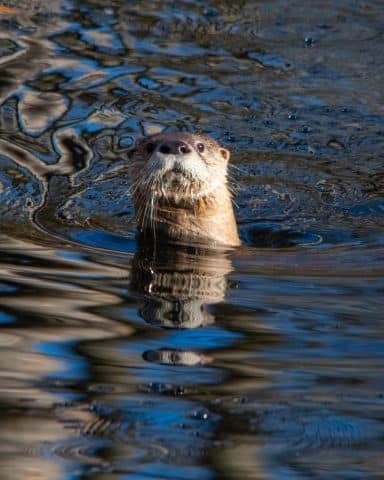You “Otter” See This!

The playful North American River otter is one of the most adorable aquatic animals found along the coast of NC. The otter’s luscious pelt, which is waterproof, helps this adorable critter regulate its body temperature and can range in color from gray and white to brown and black. River otters are much smaller than sea otters, averaging 10-30 pounds, and part of the Mustelidae family. This group of mammals includes skunks, weasels, and badgers.
Equally at home in the water and on land, river otters burrow near the water’s edge, and can thrive in rivers, lakes, swamps or estuary ecosystems. They swim by propelling themselves with their powerful tails and flexing their long bodies. Otters also have webbed feet along with nostrils and ears that close in water. In winter they remain active by using ice holes to surface and breathe. They can hold their breath underwater for up to eight minutes and dive to depths of more than 60 feet!

River otters are carnivorous and enjoy snacking on fish, amphibians, snakes, snails, worms, small mammals, birds, frogs, and turtles. These adorable animals are mostly solitary, except for females and their young. Otters come together during the mating season in late winter or early spring. Females retreat to underground homes to give birth to an average of 2-4 pups per litter. They are born with fur, but are dependent on the mother for the first six months. At seven weeks, these pups get their first introduction to the water – which consists of their mother pushing them in! River otters become mature at 2-3 years old. In the wild, otters live an average of 10 years.
Otters are an important part of a healthy, aquatic ecosystem. Finding them along a stream or river is a sign of clean water. Without these cute critters to regulate prey populations, an overabundance of these smaller animals can deplete the other animals and plants in the food web, disrupting the balance of the whole system.

The next time you are traveling through the swamp, stop by the DSWC and take a selfie with our very own “Otter Banks”!
Source:
http://naturemappingfoundation.org/natmap/facts/river_otter_k6.html
https://www.nwf.org/Educational-Resources/Wildlife-Guide/Mammals/North-American-River-Otter
https://www.fws.gov/refuge/great_swamp/visit/plan_your_visit.html
